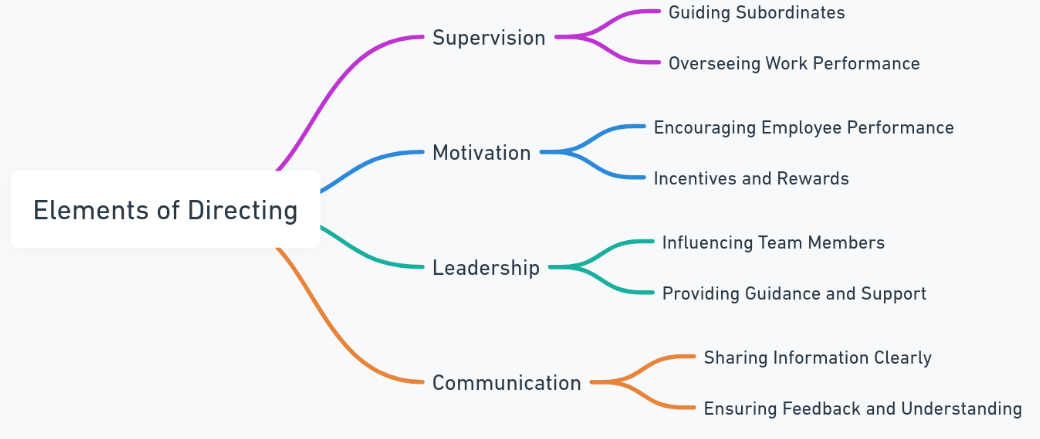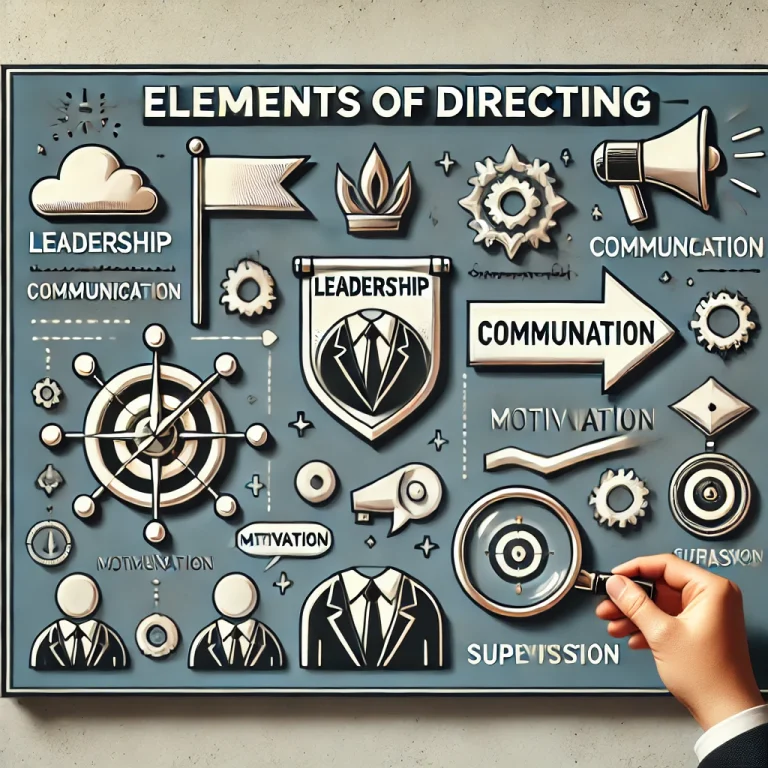Directing is essentially a primary function of management that is the driving force to achieve its objectives. Management’s elements of directing therefore play an important role so that it can lead its team through guiding and influence. This element is essentially the starting point of all effective processes of directing toward the completion of organizational objectives with coordinated action.
Managing this process is highly concerned with the success of managerial activities in any organization. Directing is referred to as the managerial function responsible for motivating and guiding organizational employees to accomplish the assigned tasks for achieving the specific goal of an organization. All the main elements of the directing process include supervision, motivation, leadership, and communication. All these elements can be specifically associated with producing an environment that helps one give their best efforts to achieve specific objectives.
Meaning of Directing
Directing will comprise the process used by the managers to command, instruct, motivate, and communicate with the staff to implement the various organizational objectives in the set framework. Therefore, directing will include leading subordinates and solving their problems as a way of improving the organizational environment to better enable effective and efficient job performance. Directing therefore can simply be defined as “to lead the staff.”.
Elements of Directing
The elements of directing, namely supervision, motivation, leadership, and communication, work together to create a cohesive approach to managing employees. In employee management, all of these elements merge into an overall approach. Each supports the other in ensuring smooth-running, productive work.

Supervision
Supervision is the process of overseeing employees’ work and ensuring that tasks are completed correctly and efficiently. It is actually giving guidance, coaching, or monitoring the activities of subordinate workers to ensure desirable output. Supervisors, thus, directly support their subordinates in terms of explaining roles assigned to them, handling tasks, and making sure of quality standards.
Role of Supervision in Directing
Management has a crucial connection with its workers through supervision. They ensure workers know what to do and also give answers to solve problems in case of questions about the position. Finally, they give instant feedback that ensures that their employees are on course with their organization’s goal.
Key Functions of Supervision
- Guidance: Supervisors help employees understand their roles and the tasks at hand.
- Feedback: They provide regular feedback, which aids in employee development and job satisfaction.
- Problem-Solving: Supervisors address issues faced by employees, whether work-related or personal, which may affect productivity.
Motivation
Motivation is the process of stimulating people to act in ways that help achieve organizational goals. Motivation is that driving force prompting an individual to put his best efforts at work. Proper motivation involves understanding what drives each employee and the appropriate incentives that can stimulate productivity.
Importance of Motivation in Directing
Motivation plays a very crucial role in guiding, as it affects the direct performance and satisfaction of the employees. Motivated workforces are highly productive and enthusiastic, thereby aligning with the organization’s objectives. Managers use many motivational tools, such as monetary rewards, recognition, and opportunities for career growth, to motivate their employees.
Types of Motivational Techniques
- Financial Incentives: Bonuses, raises, and other monetary benefits.
- Non-Financial Rewards: Recognition, awards, and promotions.
- Job Enrichment: Providing challenging tasks to foster growth and development.
Leadership
Leadership is the influence of employees to work for the goals of the organization. Leaders inspire, guide, and empower their teams to achieve their best performance. The best leadership traits that make one a successful leader are motivating, inspiring, and building trust among people.
Role of Leadership in Directing
The central theme of directing is that leaders set the tone for the organizational culture and performance standards. Leaders will use one of three primary styles of influence and guidance: autocratic, democratic, or laissez-faire. Effective leaders understand the strengths and weaknesses of their team members and utilize this information to maximize productivity and morale.
Styles of Leadership
- Autocratic Leadership: Leaders make decisions without input from team members.
- Democratic Leadership: Leaders involve team members in decision-making processes.
- Laissez-Faire Leadership: Leaders allow team members to make decisions independently within certain limits.
Communication
Communication is a process of transferring information and ideas among people in an organization. It includes the clear, concise, and effective transfer of instructions, feedback, and information. This ensures that employees know what is expected of them and are informed about developments within the organization.
Importance of Communication in Directing
Communication is the backbone of directing because it gives an employee a feeling of belonging and keeps them well-informed. Proper communication prevents misunderstandings and enhances coordination. It also plays a significant role in feedback mechanisms where employees can express their complaints and managers respond effectively.
Types of Communication in Management
- Upward Communication: From employees to managers, including feedback and suggestions.
- Downward Communication: From managers to employees, including instructions and announcements.
- Lateral Communication: Among peers or departments for better coordination.
The elements of directing—supervision, motivation, leadership, and communication—are essential components of effective management. Together, they ensure that an organization’s workforce remains productive, motivated, and aligned with organizational goals. Each element supports the others, creating a dynamic environment where employees feel valued, guided, and equipped to perform their best. Understanding and effectively implementing these elements is vital for any manager looking to create a successful and harmonious workplace.
Elements of Directing FAQs
What are the elements of directing in management?
The elements of directing include supervision, motivation, leadership, and communication. These elements work together to ensure that employees are guided, motivated, and aligned with organizational objectives.
How does supervision support the directing process?
Supervision involves guiding and monitoring employees’ tasks, ensuring they perform efficiently and as per standards. It also provides employees with immediate feedback and support.
Why is motivation important in directing?
Motivation drives employees to perform well, helping them achieve organizational goals. Motivated employees are more productive, engaged, and satisfied with their roles.
What is the role of leadership in directing?
Leadership involves influencing and inspiring employees to work toward the organization’s goals. Effective leadership helps in building a positive workplace culture and encourages teamwork.
How does communication facilitate directing?
Communication ensures that employees understand instructions and organizational updates, thereby reducing misunderstandings and promoting coordination within the team.


